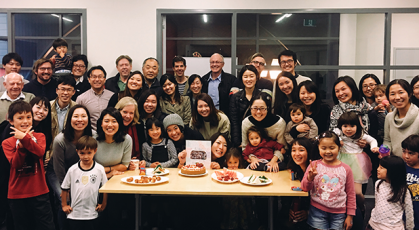It’s no secret that our city has become increasingly more multicultural, and gone are the days where suburbs were ethnic hubs. According to the last census, one in four people living in Australia were born in a non-English speaking country, and over one in three are from a non-English speaking background.
But we don’t need the data to prove this to us. We can simply walk down the street, or venture into the local food court and try to decide whether to have a hamburger, pad thai or butter chicken for lunch.

The question for us is, do our churches reflect our neighbourhoods? And what does this have to do with morning tea?
“One of the things often neglected in thinking about cross-cultural ministry is the matter of what we might need to change inside our walls and gatherings,” says Bishop Lin, who is Bishop of the Georges River Region.
“When we think about cross-cultural ministry, we tend to think about what we need to do when we go ‘out there’ to reach them. However, we don’t often think about what we might need to change once they come in the door.”
Many of our churches are welcoming and friendly, and there will usually be a smiling face handing a newcomer a Bible or a church new sheet as they enter our building.
“Keep doing that,” urges Bishop Lin, “but understand how weird and unwelcoming it might seem for an ethnic person to walk into a service, engage with the back of someone’s head for an hour, and afterwards be given a Tim Tam and a styrofoam teacup while standing in a hall that’s possibly almost empty half an hour after the service. Will they feel like you want them to stay?”

Bishop Lin desires to see all churches, collectively and individually, think about how they can make their gatherings spaces that are friendly and welcoming to many cultures. This may mean changing the way we do things. One simple area we can adjust is the way we gather over food after the service.
“Most non-Western cultures are food based,” Bishop Lin says. “Community happens around food. Food is an expression of love.
“To cook for you is to love you, and to eat is to love the cook. When we serve one biscuit, we are saying that we only want to spend time enough with you to eat a biscuit. Lots of food says we want to spend lots of time with you!”
When it comes to what we serve, it’s not just the quantity that’s important. Does the food we prepare reflect the culture of those who are in our area?
“Include the food of the people around you: baklava, spring rolls, cannoli,” Bishop Lin says. “And not just sharing your food, but eating other people’s food. It shows you love them. Eat it even if you don’t like it. Don’t be precious.”

At the heart of a multicultural morning tea, however, is not the food, but the heart behind it.
“Love is the most important thing,” Bishop Lin says. “That’s the key to embracing other cultures different to our own. Putting them and their needs first.
“Always ask what is the loving thing to do for them. Then you will listen carefully, you will be willing to change, to make sacrifices with regard to your preferences. You will truly embrace them if you love them. Love will always trump culture, and cover a multitude of cultural faux pas.”














